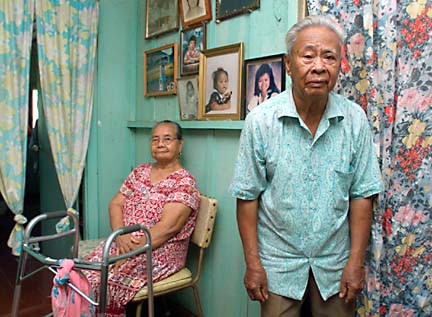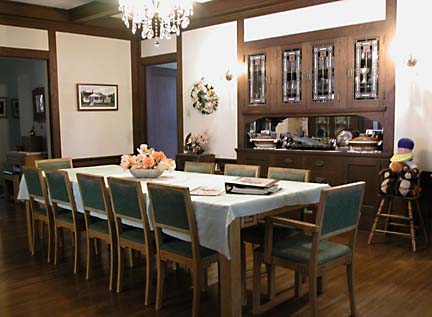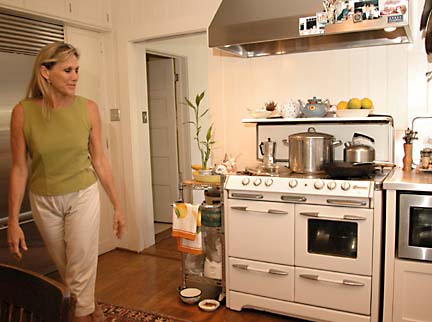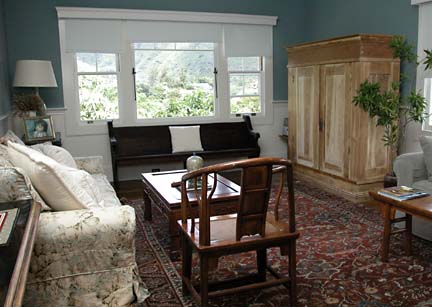
[ PLANTATION HOME ]

|
Mill Camp echoes
a far simpler time
A rustic two-bedroom plantation laborer's cottage in Waialua's Mill Camp was the first place Victoria Baguio called home when Melchor Baguio brought his new bride to Hawaii some 40 years ago.
Today, the two still live in the same faded maroon house with white trim on Hanapule Street, among a handful of plantation homes that survived the closure of the once-thriving Waialua Sugar Mill in 1996.
"Nairuam kamin," said Baguio, 86, in his native Ilocano. "We're used to it." Like the dust that coats everything in sight, they're used to it.
Besides, as a retiree of the Waialua Sugar Co., he and his wife, 82, can remain in the home for as long as they live.
The plantation homes, built using standardized plans drawn up in 1919 by the Hawaiian Sugar Planters Association and upgraded through the 1920s and 1930s, are fast disappearing from Oahu's landscape. Some remain in pockets of Kahuku, Ewa and at pineapple plantations such as Poamoho and Kunia, but many are no longer recognizable because of poor upkeep or renovations to accommodate growing families.
Baguio has made few changes to the home, distinguished by the board-and-batten exterior -- a typical example of the homes built by the sugar companies prior to the mid-1920s. The home's original cedar shingle roof has been covered over the years with nine layers of roofing paper, Baguio said.
While they have indoor plumbing, the bath -- which doubles as a laundry room -- is in a separate outhouse just steps from the back door, sort of a Filipino version of the Japanese furo. Although there is a shower, the couple prefers to bathe with water poured into large containers.
A 1919 single-family plantation home was typically about 520 square feet, or 22 feet by 24 feet with a living room, two bedrooms, a kitchen, bathroom and small porch, said Mike Faye, of Kikiaola Land Co. on Kauai, who makes a living salvaging and rebuilding plantation homes. These homes appeal to people because "they're very simple. You know where everything is, and it brings back the nostalgia of a more simple, straightforward house," Faye said.
For the Baguios, their yard is an important extension of their home.
He cultivates neat rows of ginger and eggplant with a smattering of ti plants and lauae ferns in the front yard. Long beans grow wild on the chicken wire fence that border the front yard. Out back, mango, kalamungay and papaya trees thrive along with dry-land taro, bittermelon vines, chives and tomatoes. Everything they grow, they eat or give away.
The couple's taste in furnishings reflects their simple way of life.
Matching upholstered chairs from an old dining set provide seating in the tiny living room, sparsely furnished with a table and a Zenith television that no longer works except as a stand to display numerous family photos. Hand-embroidered curtains cover the single-hung windows and the screen doors with sliding panels, also typical features of a plantation home. The new and old portraits of family that line the walls, including the one taken of the couple a week after their wedding 41 years ago, is the room's focal point. No one has bothered to change the batteries on a wall clock. Its hands are frozen at 7:43.
The utilitarian kitchen includes a pie pantry, stove and refrigerator. The window adjacent to the kitchen table looks out into their back yard and the Waianae Mountains in the distance.
Termites are a constant threat, as is the home's age, but the Baguios aren't complaining.
He does repairs as long as he is able. Because no significant changes have been made to the home since they moved in, the rent has remained at a modest $21.75 a month for as long as they can remember. Only the water bill has gone up to $25, up from $1 back when they first moved in, Victor Baguio said.
[ HISTORIC HOME ]

|
Historic homes get
tender, loving care
When you live in a historic home, you're more than just a homeowner. You're also equal parts caretaker and curator. Take Linda LeGrande, who dotes on her 78-year-old hillside-hugging Manoa home like she's caring for a beloved grandparent.
"It's a privilege and a responsibility to live in one of these houses. It's a piece of history in your community, and you're responsible for it," she says.
LeGrande is a resident of Manoa's College Hills district, a treasure trove of historic old homes above Punahou School.
She and her like-minded neighbors are doing their best to keep it that way, preserving the original style and character of their historic residences.

|
"We want to help the Manoa community to retain its original ambience. We don't want to lose that," says Ruth Tokumi, whose modest four-bedroom home, built around 1917, was designed by Oliver Traphagen, the same architect who designed the Moana Hotel and other notable Honolulu buildings.
The area was pasture land before Punahou School -- then known as Oahu College -- subdivided and sold about 100 acres it owned mauka of the school for around $1,200 a lot, a large sum at the time.
Members of Hawaii's haole establishment and faculty of the growing University of Hawaii snapped up the lots and built grand homes.
Many of these have stood the test of time despite the valley's wet weather and termites, but others are falling to the wrecking ball as the years go by, replaced by newer homes with less character.
To help stem this tide, LeGrande and neighbor Joan Dempster launched an effort in 2001 to get area homes listed on the state Register of Historic Places, ending up with about two dozen homes so far.

|

Owners of homes with a historic or architectural significance get an official bronze plaque to display outside and a lowering of annual property taxes to a flat $100, the idea being that they can plow the tax savings into preservation.
"Once a home like this is gone, there is nothing of the vintage or quality to replace it," LeGrande says.
But even with the tax savings, which can be worth thousands each year, maintaining an old home close to its original style is an uphill battle requiring hard work and ingenuity.
Over the years, LeGrande has amassed a shed full of period hardware, light fixtures and other decor items, developing a keen scavenger's radar in the process.

|
"Driving around, you see things happening. You might see an overgrown yard, talk to the neighbors, and if a house is coming down, you try to salvage what you can," she says.
The evidence is all around LeGrande's homey bungalow. Glass insulators from telephone poles serve as doorstops and paperweights; slate slabs from a dismembered billiards table pave a stone walkway; and salvaged basalt curbing stones (some with faded red "no parking" paint still visible) act as a solid exterior stairway.
"People think only the wealthy can own a historic home. But if you feel strongly enough, anyone can do it," LeGrande says.
Every other year, more than two dozen homeowners in the neighborhood open their doors to visitors as part of paid tours that snake through the leafy streets for a twin purpose: raising awareness of historic preservation and raising money for Malama O Manoa, the community group devoted to preserving Manoa's special character.

|

The tour will next be held in May.
Ruth Tokumi knows how easy it is to lose sight of the area's historical significance. Though she grew up traipsing the home's stately wraparound porch and rich interior floors of polished ohia wood, Tokumi admits she did not truly recognize the home's historic value until the historic-homes registry drive began.
She has done renovations in the past that were not truly in keeping with the home's original style. But she's relieved today that she didn't alter the home's key architectural features: the welcoming front lanai, the flooring, and elegant stained-glass built-in china cabinets.
"I never really recognized the historical significance before. We just knew it was a precious place where we all lived. But now I know it's something we have to preserve," she said.
